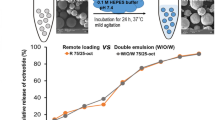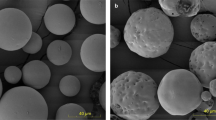Abstract
Sandostatin long-acting release® (SLAR) is a long-acting injectable somatostatin analogue formulation composed of octreotide encapsulated in glucose-initiated poly(lactic-co-glycolic acid) (PLGA) microspheres. Despite the end of patent protection, SLAR remains resistant to generic competition likely due to complexity of production process, the uniqueness of the glucose star polymer, and the instability of octreotide in the formulation. Here, we describe development of glucose-PLGA-based composition-equivalent to SLAR formulations prepared by double emulsion-solvent evaporation method and the effect of variations in encapsulation variables on release kinetics and other formulation characteristics. The following encapsulation variables were adjusted at constant theoretical loading of 7.0% peptide: PLGA concentration, pH of inner water phase, and stirring rate. After final drying, the microspheres were examined with and without annealing at 50 °C under vacuum for 3 days. The loading and encapsulation efficiency (EE) of octreotide acetate, manufacturing yield, and in vitro drug release kinetics in PBStc (10 mM phosphate-buffered saline (PBS) with 1% triethyl citrate and 0.02% sodium azide at pH 7.4) were determined by UPLC. The in vitro release and acylation kinetics of octreotide for the solvent evaporation formulations prepared were similar to SLAR although the initial burst was slightly higher. Key formulation steps identified to maximize microsphere yield and minimize residual solvent and initial burst release included (a) addition of acetic acid to the peptide before preparation and (b) annealing the microspheres under vacuum after drying. Controlled release octreotide formulations prepared and investigated in this study could provide a better understanding of the effect of production variables on release performance and supply information useful for making progress in manufacturing of SLAR generic equivalents.
Graphical abstract







Similar content being viewed by others
Data availability
All data generated or analyzed during this study are included in this published article (and its supplementary information files).
References
Broder MS, Chang E, Cherepanov D, Neary MP, Ludlam WH. Incidence and prevalence in the United States: a claims-based analysis. Endocr Pract [Internet]. American Association of Clinical Endocrinologists; 2016;22:1327–35. Available from: https://doi.org/10.4158/EP161397.OR
Ben-Shlomo A, Sheppard MC, Stephens JM, Pulgar S, Melmed S. Clinical, quality of life, and economic value of acromegaly disease control. Pituitary [Internet]. 2011;14:284–94. Available from: https://doi.org/10.1007/s11102-011-0310-7
Katznelson L, Laws Jr ER, Melmed S, Molitch ME, Murad MH, Utz A, et al. Acromegaly: an Endocrine Society Clinical Practice Guideline. J Clin Endocrinol Metab [Internet]. 2014;99:3933–51. Available from: https://doi.org/10.1210/jc.2014-2700
Beig A, Feng L, Walker J, Ackermann R, Hong JKY, Li T, et al. Physical-chemical characterization of octreotide encapsulated in commercial glucose-star PLGA microspheres. Mol Pharm [Internet]. Am Chem Soc. 2020; Available from: https://doi.org/10.1021/acs.molpharmaceut.0c00619
Bodmer D, Fong JW, Kissel T, Maulding, Hawkins V Jr, Nagele V, Oskar PJE. Sustained release formulations of water soluble peptides. US Pat. 5,538,739. USA; 1997.
Wischke C, Schwendeman SP. Principles of encapsulating hydrophobic drugs in PLA/PLGA microparticles. Int J Pharm. 2008;364:298–327.
Igari Y, Yamagata Y. Sustained-release preparation. Google Patents; 2000.
Zhang Y, Wischke C, Mittal S, Mitra A, Schwendeman SP. Design of controlled release PLGA microspheres for hydrophobic fenretinide. Mol Pharm [Internet]. Am Chem Soc. 2016;13:2622–30. Available from: https://doi.org/10.1021/acs.molpharmaceut.5b00961
Mazzara JM, Balagna MA, Thouless MD, Schwendeman SP. Healing kinetics of microneedle-formed pores in PLGA films. J Control Release. 2013;171:172–7.
Kim J, Hong D, Chung Y, Sah H. Ammonolysis-induced solvent removal: a facile approach for solidifying emulsion droplets into PLGA microspheres. Biomacromolecules American Chemical Society. 2007;8:3900–7.
Pietro L, Silva DRM, Alberto-Rincon MC, Duek EAR. The influence of triethylcitrate on the biological properties of poly (L-lactic-co-glycolic acid) membranes. J Mater Sci Mater Med [Internet]. 2006;17:849–57. Available from: https://doi.org/10.1007/s10856-006-9845-y
Kang J, Schwendeman SP. Determination of diffusion coefficient of a small hydrophobic probe in poly(lactide-co-glycolide) microparticles by laser scanning confocal microscopy. Macromolecules American Chemical Society. 2003;36:1324–30.
Li Y, Na R, Wang X, Liu H, Zhao L, Sun X, et al. Fabrication of antimicrobial peptide-loaded PLGA/chitosan composite microspheres for long-acting bacterial resistance. Molecules. 2017;22:1637.
Dos Santos KC, da Silva MFG, Pereira-Filho ER, Fernandes JB, Polikarpov I, Forim MR. Polymeric nanoparticles loaded with the 3,5,3’-triiodothyroacetic acid (Triac), a thyroid hormone: factorial design, characterization, and release kinetics. Nanotechnol Sci Appl [Internet]. Dove Medical Press; 2012;5:37–48. Available from: https://pubmed.ncbi.nlm.nih.gov/24198495
Herrmann J, Bodmeier R. Biodegradable, somatostatin acetate containing microspheres prepared by various aqueous and non-aqueous solvent evaporation methods. Eur J Pharm Biopharm [Internet]. 1998;45:75–82. Available from: http://www.sciencedirect.com/science/article/pii/S0939641197001252
Ravivarapu H, Burton K, Deluca P. Polymer and microsphere blending to alter the release of a peptide from PLGA microspheres. Eur J Pharm Biopharm. 2000;50:263–70.
Dunne M, Bibby D, Jones J, Cudmore S. Encapsulation of protamine sulphate compacted DNA in polylactide and polylactide-co-glycolide microparticles. J Control Release. 2003;92:209–19.
Wang J, Wang BM, Schwendeman SP. Mechanistic evaluation of the glucose-induced reduction in initial burst release of octreotide acetate from poly(d,l-lactide-co-glycolide) microspheres. Biomaterials [Internet]. 2004;25:1919–27. Available from: http://www.sciencedirect.com/science/article/pii/S0142961203006781
Takada S, Kurokawda T, Miyazaki K, Iwasa S, Ogawa Y. Utilization of an amorphous form of a water-soluble GPIIb/IIIa antagonist for controlled release from biodegradable microspheres. Pharm Res Springer. 1997;14:1146–50.
Ogawa Y, Yamamoto M, Takada S, Okada H, Shimamoto T. Controlled-release of leuprolide acetate from polylactic acid or copoly (lactic/glycolic) acid microcapsules: influence of molecular weight and copolymer ratio of polymer. Chem Pharm Bull. The Pharmaceutical Society of Japan; 1988;36:1502–7.
Jyothi NVN, Prasanna PM, Sakarkar SN, Prabha KS, Ramaiah PS, Srawan GY. Microencapsulation techniques, factors influencing encapsulation efficiency. J Microencapsul Taylor & Francis. 2010;27:187–97.
Kumar MNVR, Bakowsky U, Lehr C-M. Preparation and characterization of cationic PLGA nanospheres as DNA carriers. Biomaterials. 2004;25:1771–7.
Govender T, Stolnik S, Garnett MC, Illum L, Davis SS. PLGA nanoparticles prepared by nanoprecipitation: drug loading and release studies of a water soluble drug. J Control Release [Internet]. 1999;57:171–85. Available from: http://www.sciencedirect.com/science/article/pii/S0168365998001163
Yamamoto M, Takada S, Ogawa Y. Sustained release microcapsule. Google Patents; 1994.
Huang J, Mazzara JM, Schwendeman SP, Thouless MD. Self-healing of pores in PLGAs. J Control Release [Internet]. 2015;206:20–9. Available from: http://www.sciencedirect.com/science/article/pii/S0168365915001352
Amsden BG, Goosen MFA. An examination of factors affecting the size, distribution and release characteristics of polymer microbeads made using electrostatics. J Control Release Elsevier. 1997;43:183–96.
Bugarski B, Amsden B, Goosen MFA, Neufeld RJ, Poncelet D. Effect of electrode geometry and charge on the production of polymer microbeads by electrostatics. Can J Chem Eng. Wiley Online Library; 1994;72:517–21.
Klose D, Delplace C, Siepmann J. Unintended potential impact of perfect sink conditions on PLGA degradation in microparticles. Int J Pharm. 2010;404:75–82.
Doty AC, Zhang Y, Weinstein DG, Wang Y, Choi S, Qu W, et al. Mechanistic analysis of triamcinolone acetonide release from PLGA microspheres as a function of varying in vitro release conditions. Eur J Pharm Biopharm Elsevier. 2017;113:24–33.
Hirota K, Doty AC, Ackermann R, Zhou J, Olsen KF, Feng MR, et al. Characterizing release mechanisms of leuprolide acetate-loaded PLGA microspheres for IVIVC development I: in vitro evaluation. J Control Release [Internet]. 2016;244:302–13. Available from: http://www.sciencedirect.com/science/article/pii/S0168365916305508
Ogawa, Yasuaki Yamamoto, Masaki Takada, Shigeyuki Okada, Hiroaki Shimamoto T. Controlled-release of leuprolide acetate from polylactic acid or copoly(lactic/glycolic) acid microcapsules : influence of molecular weight and copolymer ratio of polymer. Chem Pharm Bull (Tokyo). 1988;36:1502–7.
Zhou J, Hirota K, Ackermann R, Walker J, Wang Y, Choi S, et al. Reverse engineering the 1-month Lupron Depot®. AAPS J. Springer; 2018;20:105.
B’Hymer C. Residual solvent testing: a review of gas-chromatographic and alternative techniques. Pharm Res [Internet]. 2003;20:337–44. Available from: https://doi.org/10.1023/A:1022693516409
Murty SB, Thanoo BC, Wei Q, DeLuca PP. Impurity formation studies with peptide-loaded polymeric microspheres: part I. In vivo evaluation. Int J Pharm [Internet]. 2005;297:50–61. Available from: http://www.sciencedirect.com/science/article/pii/S0378517305001791
Murty S, Goodman J, Thanoo B, Deluca P. Identification of chemically modified peptide from poly(D, L-lactide-co-glycolide) microspheres under in vitro release conditions. AAPS PharmSciTech. 2003;4:E50.
Na DH, DeLuca PP. PEGylation of octreotide: I. Separation of positional isomers and stability against acylation by poly(D,L-lactide-co-glycolide). Pharm Res. 2005;22:736–42.
Na DH, Lee KC, DeLuca PP. PEGylation of octreotide: II. Effect of N-terminal mono-PEGylation on biological activity and pharmacokinetics. Pharm Res [Internet]. 2005;22:743–9. Available from: https://doi.org/10.1007/s11095-005-2590-y
Ding AG, Shenderova A, Schwendeman SP. Prediction of microclimate pH in poly(lactic-co-glycolic acid) films. J Am Chem Soc [Internet]. American Chemical Society; 2006;128:5384–90. Available from: https://doi.org/10.1021/ja055287k
Shenderova A, Ding AG, Schwendeman SP. Potentiometric method for determination of microclimate pH in poly(lactic-co-glycolic acid) films. Macromolecules [Internet]. J Am Chem Soc. 2004;37:10052–8. Available from: https://doi.org/10.1021/ma0481959
Estey T, Kang J, Schwendeman SP, Carpenter JF. BSA Degradation under acidic conditions: a model for protein instability during release from PLGA delivery systems. J Pharm Sci [Internet]. Elsevier; 2006;95:1626–39. Available from: https://doi.org/10.1002/jps.20625
Kang J, Schwendeman SP. Comparison of the effects of Mg(OH)2 and sucrose on the stability of bovine serum albumin encapsulated in injectable poly(d,l-lactide-co-glycolide) implants. Biomaterials [Internet]. 2002;23:239–45. Available from: http://www.sciencedirect.com/science/article/pii/S0142961201001016
Sophocleous AM, Zhang Y, Schwendeman SP. A new class of inhibitors of peptide sorption and acylation in PLGA. J Control Release [Internet]. 2009;137:179–84. Available from: http://www.sciencedirect.com/science/article/pii/S0168365909001813
Na DH, Murty SB, Lee KC, Thanoo BC, DeLuca PP. Preparation and stability of poly(ethylene glycol) (PEG)ylated octreotide for application to microsphere delivery. AAPS Pharm Sci Tech [Internet]. 2003;4:E72. Available from: https://europepmc.org/articles/PMC2750665
Vaishya RD, Mandal A, Gokulgandhi M, Patel S, Mitra AK. Reversible hydrophobic ion-paring complex strategy to minimize acylation of octreotide during long-term delivery from PLGA microparticles. Int J Pharm [Internet]. 2015;489:237–45. Available from: http://www.sciencedirect.com/science/article/pii/S0378517315003956
Sophocleous AM, Desai K-GH, Mazzara JM, Tong L, Cheng J-X, Olsen KF, et al. The nature of peptide interactions with acid end-group PLGAs and facile aqueous-based microencapsulation of therapeutic peptides. J Control Release. 2013;172:662–70.
Le M-Q, Violet F, Paniagua C, Garric X, Venier-Julienne M-C. Penta-block copolymer microspheres: impact of polymer characteristics and process parameters on protein release. Int J Pharm [Internet]. 2018;535:428–37. Available from: http://www.sciencedirect.com/science/article/pii/S0378517317310888
Bilati U, Allémann E, Doelker E. Strategic approaches for overcoming peptide and protein instability within biodegradable nano- and microparticles. Eur J Pharm Biopharm [Internet]. 2005;59:375–88. Available from: http://www.sciencedirect.com/science/article/pii/S0939641104002875
Na DH, Lee JE, Jang SW, Lee KC. Formation of acylated growth hormone-releasing peptide-6 by poly(lactide-co-glycolide) and its biological activity. AAPS PharmSciTech [Internet]. 2007;8:E105–9. Available from: https://doi.org/10.1208/pt0802043
Ghassemi AH, van Steenbergen MJ, Barendregt A, Talsma H, Kok RJ, van Nostrum CF, et al. Controlled release of octreotide and assessment of peptide acylation from poly(D,L-lactide-co-hydroxymethyl glycolide) compared to PLGA microspheres. Pharm Res [Internet]. 2012;29:110–20. Available from: https://doi.org/10.1007/s11095-011-0517-3
Acknowledgements
This paper reflects the views of the authors and should not be construed to represent the FDAʼs views or policies.
Funding
This research was funded by FDA grant U01 FD005847.
Author information
Authors and Affiliations
Contributions
All authors discussed the results and contributed to the final manuscript.
Corresponding author
Ethics declarations
Research involving humans and animals participants
No animal or human studies were carried out by the authors for this article.
Consent for publication
This paper reflects the views of the authors and should not be construed to represent the FDA’s views or policies.
Competing interests
The authors declare no competing interests.
Additional information
Publisher's Note
Springer Nature remains neutral with regard to jurisdictional claims in published maps and institutional affiliations.
Supplementary Information
Below is the link to the electronic supplementary material.
Rights and permissions
About this article
Cite this article
Beig, A., Feng, L., Walker, J. et al. Development and characterization of composition-equivalent formulations to the Sandostatin LAR® by the solvent evaporation method. Drug Deliv. and Transl. Res. 12, 695–707 (2022). https://doi.org/10.1007/s13346-021-01013-5
Accepted:
Published:
Issue Date:
DOI: https://doi.org/10.1007/s13346-021-01013-5




